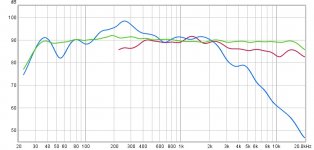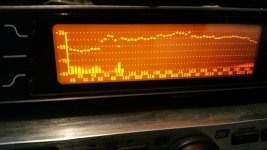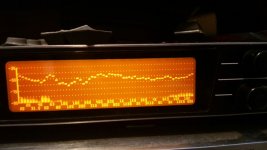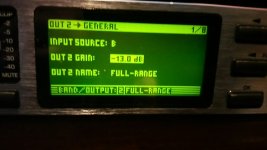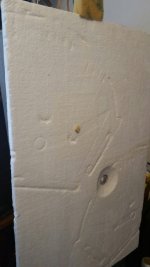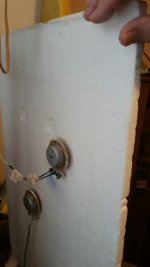Cheapvega.
If you want to go down to 40hz with a canvas panel then a thin ply panel is necessary.
If you only need to go down to say 125hz or 300hz then the panel is not necessary.
Centre placement is not the norm on a dml panel,for the reasons you suggested,but the combination of the canvas acting on the panel and the canvas being quite lossy, standing waves don't seem to be a problem(I've only just been experimenting with This so don't really want to make outlandish statements) and the sound sounds pretty good, to me anyway?
I am also not sure if a larger panel would be better or not ?
I have at least 30 different panels lying around my house, I'd rather not have any more if I can help it ,especially large panels.
I would probably use two of more panels per channel for more power, hopefully someone will try a large canvas panel and we will find out ?
If your xps panels are clipping it sounds like you are over driving the exciters, over use of dsp can sometimes damage drive units.
Some time ago I tried to fill a room dip with eq on an 8inch piston driver at about 120hz ,it sounded ok but when I played some loud music with a lot of energy at about 120hz my coils started to part from the former, not a very nice sound.
Steve.
If you want to go down to 40hz with a canvas panel then a thin ply panel is necessary.
If you only need to go down to say 125hz or 300hz then the panel is not necessary.
Centre placement is not the norm on a dml panel,for the reasons you suggested,but the combination of the canvas acting on the panel and the canvas being quite lossy, standing waves don't seem to be a problem(I've only just been experimenting with This so don't really want to make outlandish statements) and the sound sounds pretty good, to me anyway?
I am also not sure if a larger panel would be better or not ?
I have at least 30 different panels lying around my house, I'd rather not have any more if I can help it ,especially large panels.
I would probably use two of more panels per channel for more power, hopefully someone will try a large canvas panel and we will find out ?
If your xps panels are clipping it sounds like you are over driving the exciters, over use of dsp can sometimes damage drive units.
Some time ago I tried to fill a room dip with eq on an 8inch piston driver at about 120hz ,it sounded ok but when I played some loud music with a lot of energy at about 120hz my coils started to part from the former, not a very nice sound.
Steve.
Lordtarquin.
I've always found ply to have a rising response above about 10k to 20k ?
I have shown plots of this.
I'd say eps is at least 8db louder than ply and probably more.
There are recordings of my panels on this forum for you to make up your own mind which you like or not.
I think they all sound good, or I would not post them,but everyone has different tastes.
Higher grades of eps will have a better low and high frequency response ,but which sounds best is up to you?
It all depends on the xo you want and what you do to reach the higher frequencies.
Steve.
I've always found ply to have a rising response above about 10k to 20k ?
I have shown plots of this.
I'd say eps is at least 8db louder than ply and probably more.
There are recordings of my panels on this forum for you to make up your own mind which you like or not.
I think they all sound good, or I would not post them,but everyone has different tastes.
Higher grades of eps will have a better low and high frequency response ,but which sounds best is up to you?
It all depends on the xo you want and what you do to reach the higher frequencies.
Steve.
Car!mart.
Please do not push wood under the canvas to tighten it, this was only a quick test to see what happened.
As I have said there are recordings of my panels on this forum including the art panels.
I know it's not easy trying to find them, even I have trouble finding them.
A panel either produces low frequencies or it does not,you can try to force it to, but is it worth it ?
I use my TLS below 300hz to sort out room suck outs,so running the panel below say 90hz seems a bit pointless,and the stresses on the panel can be quite destructive to the sound and panel,and exciter of course.
I know there are ways to increase the low end response but there is always a price to pay with the sound of the rest of the panel( I find ).
Steve.
Please do not push wood under the canvas to tighten it, this was only a quick test to see what happened.
As I have said there are recordings of my panels on this forum including the art panels.
I know it's not easy trying to find them, even I have trouble finding them.
A panel either produces low frequencies or it does not,you can try to force it to, but is it worth it ?
I use my TLS below 300hz to sort out room suck outs,so running the panel below say 90hz seems a bit pointless,and the stresses on the panel can be quite destructive to the sound and panel,and exciter of course.
I know there are ways to increase the low end response but there is always a price to pay with the sound of the rest of the panel( I find ).
Steve.
Sonnar.
Those are diy jobs.
There is a guy who tests them on YouTube, I believe he has posted on diy audio,can't remember his name.
I'll look again.
But I found this guy ,and thought some might be interested ?
DIY LARGE Speakers UNDER $100 - YouTube
Steve.
Those are diy jobs.
There is a guy who tests them on YouTube, I believe he has posted on diy audio,can't remember his name.
I'll look again.
But I found this guy ,and thought some might be interested ?
DIY LARGE Speakers UNDER $100 - YouTube
Steve.
Thanks Steve.
This is where I was before the exciter mishap. Green is the EQed response from my listening position for the left side, Blue for the OB bass driver before EQ, and red for the panel before EQ. The right hand speaker is a little different due to positioning.
The OB bass response curve is obviously rather lumpy. But with EQ gives a far nicer bass than a traditional box speaker.
Any extra efficiency from the EPS panels will give me more wiggle room with EQing.
This is where I was before the exciter mishap. Green is the EQed response from my listening position for the left side, Blue for the OB bass driver before EQ, and red for the panel before EQ. The right hand speaker is a little different due to positioning.
The OB bass response curve is obviously rather lumpy. But with EQ gives a far nicer bass than a traditional box speaker.
Any extra efficiency from the EPS panels will give me more wiggle room with EQing.
Attachments
Lordtarquin.
Sorry for these rushed measurements, I manged to find an old 15mm eps panel that I haven't managed to totally destroy yet.
The first picture is of the eps plot I'm not sure what grade it was as it was used for packing but definitely not as high as 70 grade.
The second the naked canvas which would have about the same efficiency as a ply panel maybe a bit more ? And shows the volume drop.
The third pic is of the 13db drop in gain to the eps panel to match the output levels.
The last two pictures is of the now defunct test panel which is coated in a couple of layers of tissue (bog paper) and pva ,so is pretty heavily damped already.
The top exciter only was used for this test.
Steve
Sorry for these rushed measurements, I manged to find an old 15mm eps panel that I haven't managed to totally destroy yet.
The first picture is of the eps plot I'm not sure what grade it was as it was used for packing but definitely not as high as 70 grade.
The second the naked canvas which would have about the same efficiency as a ply panel maybe a bit more ? And shows the volume drop.
The third pic is of the 13db drop in gain to the eps panel to match the output levels.
The last two pictures is of the now defunct test panel which is coated in a couple of layers of tissue (bog paper) and pva ,so is pretty heavily damped already.
The top exciter only was used for this test.
Steve
Attachments
Lordtarquin.
I see the hf peak above 10k that i expect from ply but am a bit mystified by the slow roll off above 2k ?
Do you use the sticky rings supplied with the exciter ?
Could be the exciter itself of course?
And that looks like a big room suckout at about 50hz have you tried to fix this by adjusting the room or using an extra sub?
Steve.
I see the hf peak above 10k that i expect from ply but am a bit mystified by the slow roll off above 2k ?
Do you use the sticky rings supplied with the exciter ?
Could be the exciter itself of course?
And that looks like a big room suckout at about 50hz have you tried to fix this by adjusting the room or using an extra sub?
Steve.
Steve,
Yes, that room suckout is annoying. The room doubles as my study and photography stuff room. At only 12 x 14 feet, it's on the small side, and with doors in awkward places. I don't have a sub at the moment and may struggle to find room for one.
It could indeed be the exciter accounting for the >2khz falloff. It's not inconsistent with the published frequency response chart for that exciter which shows a marked reduction in output from just below 2k. I used some very sticky double sided material for the fixing. For the final speaker, once my brother has found time to CNC a frame complete for me from 20mm solid black MDF, I'll probably try epoxy glue.
https://www.daytonaudio.com/images/resources/295-224--dayton-audio-daex25fhe-4-specifications.pdf
Yes, that room suckout is annoying. The room doubles as my study and photography stuff room. At only 12 x 14 feet, it's on the small side, and with doors in awkward places. I don't have a sub at the moment and may struggle to find room for one.
It could indeed be the exciter accounting for the >2khz falloff. It's not inconsistent with the published frequency response chart for that exciter which shows a marked reduction in output from just below 2k. I used some very sticky double sided material for the fixing. For the final speaker, once my brother has found time to CNC a frame complete for me from 20mm solid black MDF, I'll probably try epoxy glue.
https://www.daytonaudio.com/images/resources/295-224--dayton-audio-daex25fhe-4-specifications.pdf
Lordtarquin.
Yes I would expect the roll off on the foamcore board Dayton use for those plots ,why they use foamcore is a mystery to me ?
I always use a bead of neat pva on the exciter foot with no problems with HF, the panel is coated in pva anyway.
The panel will rip apart before the exciter comes off !
If the panel is lighter than the exciter I would suggest mounting the exciter to something rigid ? And just hang the panel from the coil and let the suspension and eps have an easier time.
A solid frame is not needed and might hinder the sound ,this is an omnidirectional panel,the low end drops off but the mids and highs are still strong, measure it from the side and see for yourself.
Steve.
Yes I would expect the roll off on the foamcore board Dayton use for those plots ,why they use foamcore is a mystery to me ?
I always use a bead of neat pva on the exciter foot with no problems with HF, the panel is coated in pva anyway.
The panel will rip apart before the exciter comes off !
If the panel is lighter than the exciter I would suggest mounting the exciter to something rigid ? And just hang the panel from the coil and let the suspension and eps have an easier time.
A solid frame is not needed and might hinder the sound ,this is an omnidirectional panel,the low end drops off but the mids and highs are still strong, measure it from the side and see for yourself.
Steve.
To broach a subject that I don't remember this remarkable discussion addressing..
What would it take to create a DML low frequency panel that one could pair with some of the great mid and high frequency DML builds explored herein?
Larger panels?
Best materials?
Different exciters?
Custom (DIY) exciters?
Multiple exciters?
Why not a DML bass or sub woofers?
What would it take to create a DML low frequency panel that one could pair with some of the great mid and high frequency DML builds explored herein?
Larger panels?
Best materials?
Different exciters?
Custom (DIY) exciters?
Multiple exciters?
Why not a DML bass or sub woofers?
Steve
I've been labouring under an assumption that some sort of edge suspension was desirable, going back to some of the original research papers and postings by an ex member DMLBES. What he advocated was edge constraints plus exciter supported / attached to what he called a 'spline'.
So if I read things correctly, an exciter attached to some EPS where the exciter is mounted to a rigid spine or similar type thing and the EPS is effectively free from any edge or corner constraints (i.e. effectively free floating) is the way forward. I'm not worried about anything lower than 300hz as I have the 15 inch bass drivers. If this is correct, then I've saved myself quite a bit of work.
Simon.
I've been labouring under an assumption that some sort of edge suspension was desirable, going back to some of the original research papers and postings by an ex member DMLBES. What he advocated was edge constraints plus exciter supported / attached to what he called a 'spline'.
So if I read things correctly, an exciter attached to some EPS where the exciter is mounted to a rigid spine or similar type thing and the EPS is effectively free from any edge or corner constraints (i.e. effectively free floating) is the way forward. I'm not worried about anything lower than 300hz as I have the 15 inch bass drivers. If this is correct, then I've saved myself quite a bit of work.
Simon.
Lordtarquin.
Ten years ago over on the NXT RUBBISH forum (audiocircle) I used to call my panels free floating panels 😀
It's only taken ten years for someone to notice this,thank you 🙄
You will find that just gently touching the eps panel with your fingers will change the sound of the panel,so you can imagine what attaching some sort of edge mounting will do.
Ply or some other hard heavy type panel is another story,I treat them differently,rigidly mounting can sometimes help the sound,it all depends on what you want?
Heavy panels need lots of power to drive them,compared to eps which only needs a few watts,so only the slightest of movement of the coil produces lots of delicate sound,but also huge dynamics.
Any form of clamping or damping will impinge on this.
I try to do as little as possible to my panels,and this serves me well.
Believe me I have on many occasions manipulated the sound of panels for better frequency response and extended range,but the sound always suffers😕.
An xo of anywhere between 90hz to 300hz for the eps is possible and a xo of 300hz for your OB sub would be my choice.
You might get away with only a slight midrange hump which is easily reduced ,for a flat response.
But we will have to wait and see what the response of the panel is first ,I'll keep my fingers crossed.
Steve.
Ten years ago over on the NXT RUBBISH forum (audiocircle) I used to call my panels free floating panels 😀
It's only taken ten years for someone to notice this,thank you 🙄
You will find that just gently touching the eps panel with your fingers will change the sound of the panel,so you can imagine what attaching some sort of edge mounting will do.
Ply or some other hard heavy type panel is another story,I treat them differently,rigidly mounting can sometimes help the sound,it all depends on what you want?
Heavy panels need lots of power to drive them,compared to eps which only needs a few watts,so only the slightest of movement of the coil produces lots of delicate sound,but also huge dynamics.
Any form of clamping or damping will impinge on this.
I try to do as little as possible to my panels,and this serves me well.
Believe me I have on many occasions manipulated the sound of panels for better frequency response and extended range,but the sound always suffers😕.
An xo of anywhere between 90hz to 300hz for the eps is possible and a xo of 300hz for your OB sub would be my choice.
You might get away with only a slight midrange hump which is easily reduced ,for a flat response.
But we will have to wait and see what the response of the panel is first ,I'll keep my fingers crossed.
Steve.
Many thanks Steve.
This is a tremendous help. My objective is to get the best sound I can for as little expense and effort as I can get away with. My main interest is photography and this gets the lions share of the leisure budget and time. But with the winter months and dark evenings coming, I see music playing alongside lots of slide scanning, digital photo culling etc.
My MiniDSP HD has a lot of levers to pull with respect to EQ, but the fewer I have to use to sort out the big deviations, the more I have for fine-tuning. The frequency plots you get from your free floating EPS panels look excellent. In particular, your very top end response is better than that which I have achieved with 3mm ply.
I'm now wondering whether 400 x 565mm for a panel that only needs to be effective from 300hz upwards is actually too large and whether something smaller may actually be better.
Anyway, thanks so much for your help. I just need those new exciters to arrive! Meanwhile, I will experiment with my one working exciter and a spare bit of EPS.
This is a tremendous help. My objective is to get the best sound I can for as little expense and effort as I can get away with. My main interest is photography and this gets the lions share of the leisure budget and time. But with the winter months and dark evenings coming, I see music playing alongside lots of slide scanning, digital photo culling etc.
My MiniDSP HD has a lot of levers to pull with respect to EQ, but the fewer I have to use to sort out the big deviations, the more I have for fine-tuning. The frequency plots you get from your free floating EPS panels look excellent. In particular, your very top end response is better than that which I have achieved with 3mm ply.
I'm now wondering whether 400 x 565mm for a panel that only needs to be effective from 300hz upwards is actually too large and whether something smaller may actually be better.
Anyway, thanks so much for your help. I just need those new exciters to arrive! Meanwhile, I will experiment with my one working exciter and a spare bit of EPS.
Given the difficulty in obtaining exciters these days, does anyone have any suggestions for making them. Magnets. Coils. Terminals. Wire. Something to mount it all together.
Maybe possible to tear up a small woofer.
Thoughts and guidance appreciated.
Maybe possible to tear up a small woofer.
Thoughts and guidance appreciated.
Given the difficulty in obtaining exciters these days, does anyone have any suggestions for making them. Magnets. Coils. Terminals. Wire. Something to mount it all together.
Maybe possible to tear up a small woofer.
Thoughts and guidance appreciated.
A fun diy job.
- Home
- Loudspeakers
- Full Range
- A Study of DMLs as a Full Range Speaker
